Rennie Scaysbrook | April 27, 2017
Suzuki is back in the superbike game. Hallelujah!
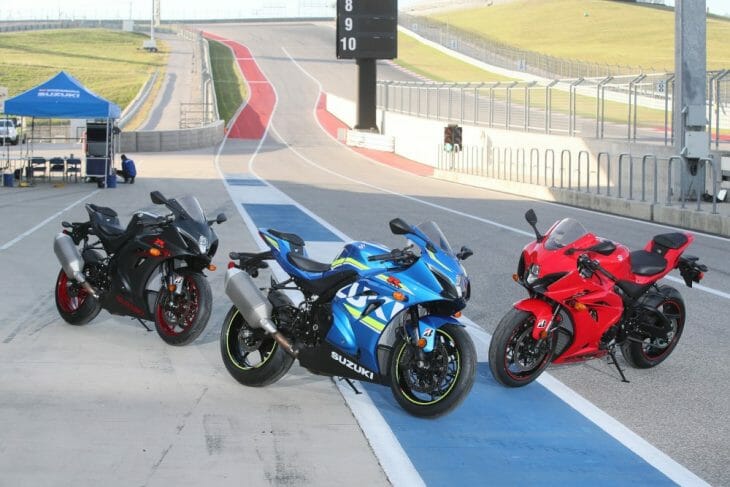 The GSX-R1000 comes in three flavors, but the blue and white has to be the winner in our book.
The GSX-R1000 comes in three flavors, but the blue and white has to be the winner in our book.
Not once since the 1000cc superbike debuted in 1998 have we seen such a plethora of astounding motorcycles to get our speed junkie fix on. The selection is now that nearly every manufacturer who has a 1000cc sportbike on offer has more than one version to choose from, and now we can finally add one of the real OG superbike creators to that club with the 2017 Suzuki GSX-R1000 range.
Well, the above statement isn’t entirely correct, because the GSX-R1000 has come in base and ABS models for some time, but the addition of the GSX-R1000R that came out in February moves the Big S right up the food chain when it comes to customer choice in 2017.
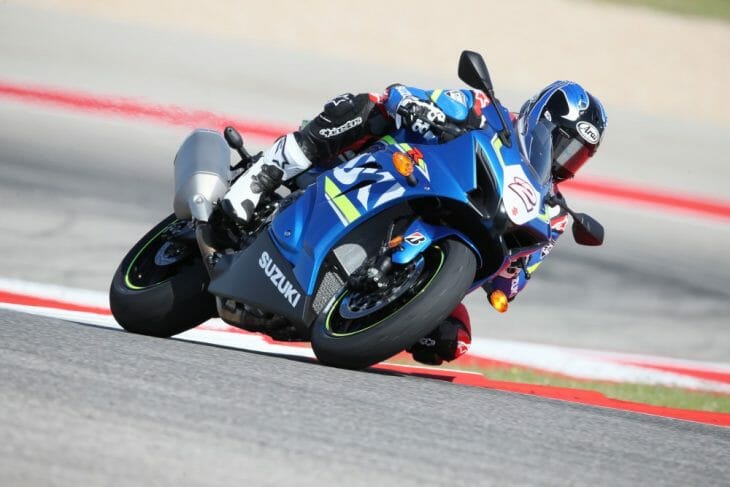 A certain MotoGP Legend made an appearance at COTA for the test… Kenny Roberts Jnr showed the assembled journos he’s lost none of his style and speed.
A certain MotoGP Legend made an appearance at COTA for the test… Kenny Roberts Jnr showed the assembled journos he’s lost none of his style and speed.
We have yet to sample the big daddy 1000R here at Cycle News, something that will happen in the very near future, so for us, the base model GSX-R1000 will serve as our introduction to the 2017 machine—a bike Suzuki is hoping will take it back to the top of the superbike heap after several years in the wilderness.
Like the Honda CBR1000RR, it’s been nearly 10 years since we’ve seen a new GSX-R1000. Well, seven, actually, but that’s a lifetime in modern superbike terms. The game has moved so, so far since then, but Suzuki know how to build a good bike when they want to, and the title of King of Superbike is one they dearly want back after having a mortgage on it for a couple of decades.
There’s a lot of tech to get through with this bike, so if you’d just like to know how it rides, head down to the bottom of this page.
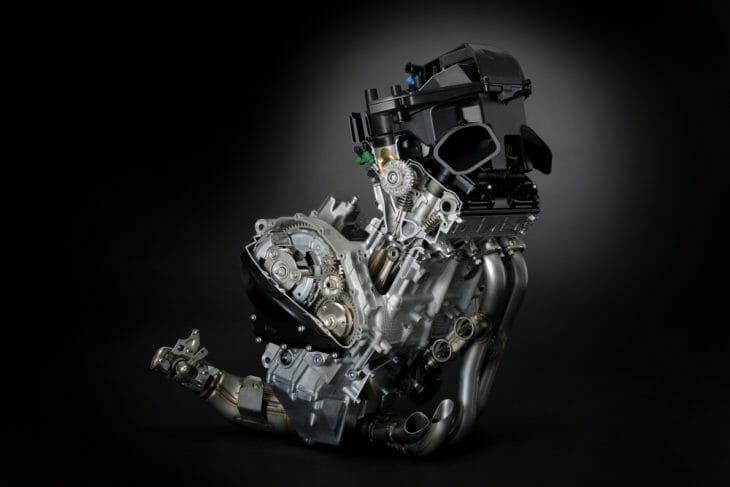 There’s very, very little that hasn’t been changed in the new Suzuki motor.
There’s very, very little that hasn’t been changed in the new Suzuki motor.
More revs, more power
Smaller, lighter, faster—that’s the superbike game in 2017. Dimensionally Suzuki’s achieved the smaller part of the equation as the 2017 motor is 22.2mm shorter front to back and 6.6mm narrower side to side.
The new in line four-cylinder motor’s stroke has been reduced from 57.3mm to 55.1, with the bore increased from 74.5mm to 76mm to give more revs and more top end power at the 14,500rpm redline, up by 1000rpm. There’s also more compression (13.2:1 vs the 2016’s 12.9:1), a new, lighter finger follower valve train acting on the valves that does away with old school valve tappets, a larger airbox, a new Suzuki Ram Air Direct (SRAD) system and a new Ride-By-Wire throttle and intake system housing new primary and secondary fuel injectors.
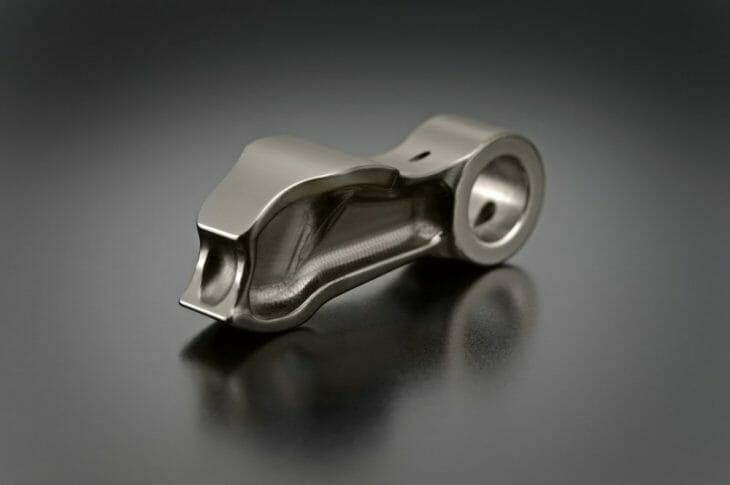 Brand new, lightweight finger followers replace the tappet system of the 2016 model.
Brand new, lightweight finger followers replace the tappet system of the 2016 model.
The secondary injectors spray fuel from the top of the air box directly into the intake funnels, resulting in higher peak power, more efficient combustion, and better fueling control. The system works together with the Stacked Air Intake Funnels on cylinders one and four and isn’t a variable intake system like on the Yamaha YZF-R1—Suzuki wanted a fixed system so no extra weight and complexity was added to the GSX-R.
But the big talking point is the new Variable Valve Timing (VVT) system, a mechanism that’s been used by Suzuki in MotoGP for the past decade. MotoGP racing banned hydraulically and electronically adjustable VVT systems some time ago, but the Suzuki system isn’t hydraulic or electronic—it’s mechanical.
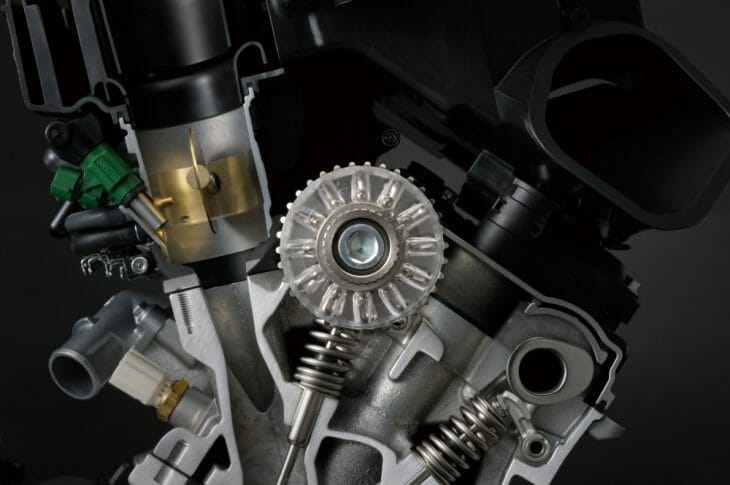 Here you can see the balls located in the cam grooves (white sprocket).
Here you can see the balls located in the cam grooves (white sprocket).
The Suzuki VVT system splits the camshaft sprocket into two halves, with one half carrying the sprocket itself, the other attaching to the camshaft, allowing for four degrees of rotation between the two pieces. On the inside of both faces are radial grooves that house 12 steel balls and as the revs rise, centrifugal force pushes the balls outwards, up the grooves and varies the cam timing.
To achieve this, the two halves are phased slightly apart and the edge of the radial grooves are shallower, meaning the balls must force their way through the grooves, separating the two halves and changing the timing. This also ensures the VVT system won’t activate until high up in the rev range with the required centrifugal force acting on it. The camshaft part of the VVT system is on a spline, so it can move in and out while still allowing the camshaft itself to turn. To close the system, Suzuki uses a good old fashioned spring.
The VVT system kicks in at 10,000rpm, giving greater valve overlap for more peak power than the reduced overlap and high torque required for 0-10,000rpm. For a detailed look at the system, check out this video.
On the exhaust side, Suzuki’s fitted the new Suzuki Exhaust Tuning-Alpha (SET-A) system. Suzuki’s had the SET system for a while, but the addition of the A is worth talking about. The new system has exhaust valves in the balance tubes between the number one and four, and two and three header pipes. The system opens and closes the valves via a cable depending on the engine revs—open for peak power and closed for bottom-end torque—in that way it’s like the Yamaha EXUP system that’s been in use in their mid-pipes for forever.
The 2017 GSX-R1000 gets the power to the ground via a new cassette-style transmission Suzuki says takes only about half an hour to remove. There’s also a new Suzuki Clutch Assist System (SCAS) that has larger ramps between the sleeve hub and the clutch basket. The system works like a slipper clutch during downshifts, smoothing engine braking while increasing pressure on the plates during acceleration. Suzuki says the system is so good they only need three clutch springs in total, making for a very light pull at the lever.
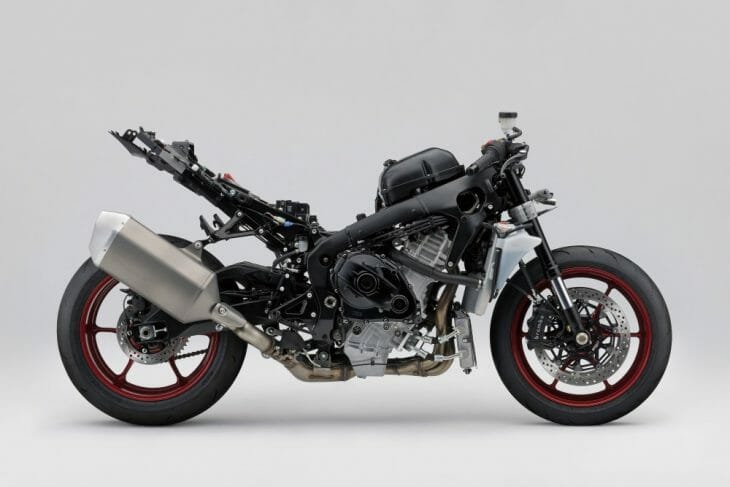 OK, we’ll admit it. That muffler does look horrendous.
OK, we’ll admit it. That muffler does look horrendous.
The lovely bones
Suzuki’s been using the term Run, Turn, Stop with the new GSX-R. The new engine runs pretty damn good, but how about turning and stopping? Well, the Hamamatsu crew has given the GSX-R an all new chassis and swingarm, complimented by Showa springers and Brembo stoppers.
The new twin spar chassis is smaller, 10 percent lighter and far more compact than in 2016. Never really one of the porkier 1000s out there, the GSX-R is now 20mm narrower between the spars with the motor rotated six degrees rearward in the chassis. That’s allowed much tighter packaging—the distance from the front axle to the swingarm pivot is 20mm shorter, with the swingarm itself 40mm longer. The wheelbase has grown 15mm to 1420mm, although trail has been reduced to 3.74in from 3.85in.
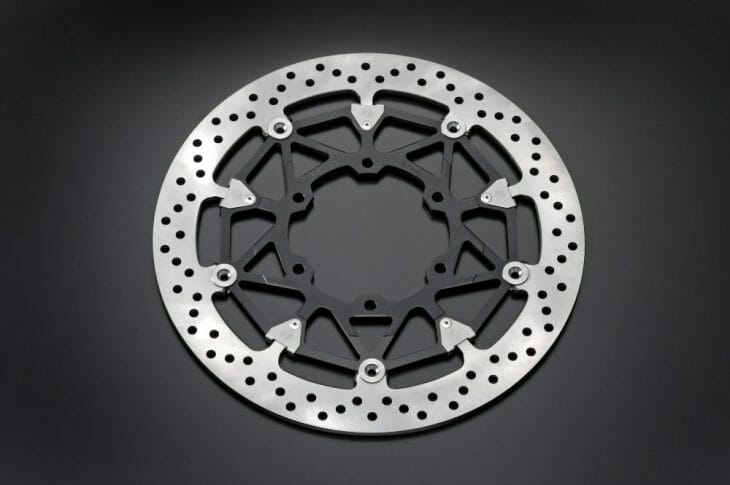 This is the new Brembo T-drive disc, characterized buy the silver T-fasteners (5) on the disc.
This is the new Brembo T-drive disc, characterized buy the silver T-fasteners (5) on the disc.
Brembo has supplied the front brakes for the GSX-R with dual radially-mounted four-piston calipers up front gripping the company’s new T-drive 320mm discs. What is T-drive, I hear you ask? Well, it features two methods of attaching the 320mm floating disc to the carrier. There are five conventional floating disc spools that maintain the discs’ relationship to the caliper, and there are five new T-drive fasteners.
The T-drive is claimed to produce a larger contact area between the outer and inner brake discs, allowing fewer mounting points than conventional mounts (10 instead of 12). That minimizes weight gain despite the bigger diameter disc (320mm for the 2017 bike versus 310mm for the 2016). The T-drive is also claimed to reduce the rattle noises associated with floating discs. Nissin takes care of the rear brake with a single piston caliper and 240mm disc.
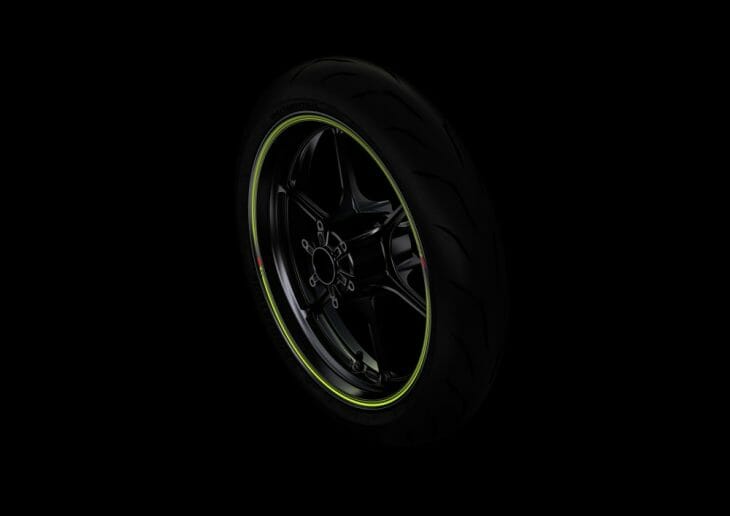 New six spoke wheels replace the three spokers from last year.
New six spoke wheels replace the three spokers from last year.
Showa’s thrown their fully-adjustable 43mm Big Piston Fork at the GSX-R—the same unit found on the base model Honda CBR1000RR—plus their fully-adjustable Remote Reservoir Shock, and the show rolls on brand new six spoke cast alloy wheels wrapped in Bridgestone RS10 tires as standard.
There’s no point showing up to the ball in an old dress, so Suzuki’s given the GSX-R a full cosmetic makeover with a much skinner seat section, a 21mm lower gas tank (with a corresponding 0.4-gallon reduction in capacity to 4.2-gallon), and a reworked front with a much smaller LED headlight but without the LED daytime running lights of the GSX-R1000R.
Electronic elephant in the room
This is the first GSX-R1000 to come with not just traction control but also an Inertial Measurement Unit. The must-have gizmo of 2015 has now finally made its way to the GSX-R (to be fair to Suzuki, they were originally going to release the GSX-R1000 as a 2016 model, but delayed it one more year).
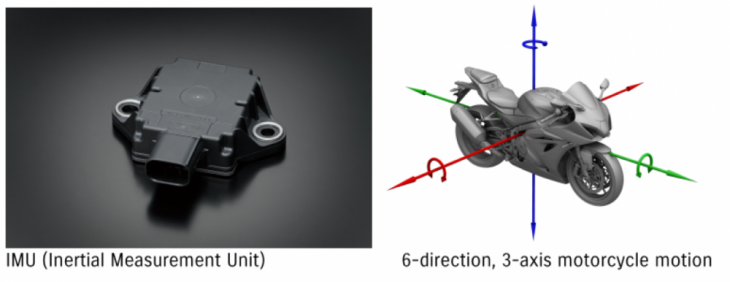 The new IMU–nice to see you arriving at the Suzuki party!
The new IMU–nice to see you arriving at the Suzuki party!
The Suzuki’s IMU measures the machine in six axis—pitch up and down, roll left and right, and yaw left and right—and communicates that information to the ECM to determine the intervention of traction and wheelie control. The GSX-R1000 doesn’t run separate wheelie and traction maps like the Yamaha YZF-R1 and in this guise, is like the 2017 CBR1000RR.
Dubbed Motion Track Traction Control, it’s a 10-stage system with nine levels plus Off that takes in inputs from the Throttle Position Sensor, Acceleration Position Sensor, IMU, ECM, front and rear wheel speed sensors, Gear Position Sensor and the Crank Position Sensor to determine rear wheel slip and the torque allocated to the rear wheel. Levels one to four are designed for track use, five to eight for road twisties and nine to 10 for wet weather riding.
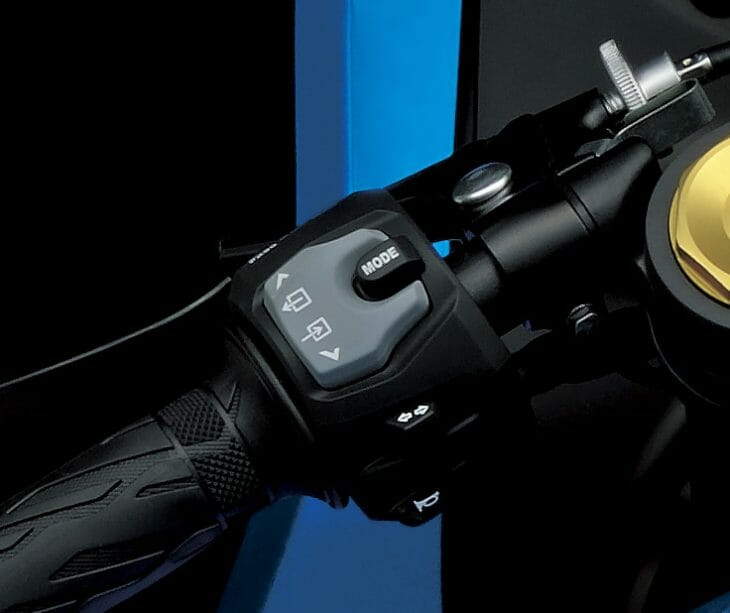 It’s all accessed by this little innocent button on your left handlebar.
It’s all accessed by this little innocent button on your left handlebar.
Back for another crack this year is the three-stage Suzuki Drive Mode Selector (S-DMS) system, but unlike previous years where it would change the overall power of the bike in the mode you were in, the 2017 version just softens the initial torque delivery while still giving you all the power at the top of the rev range with Mode A the most aggressive, Mode C the least.
There’s also the Suzuki Easy Start one-touch system and the Low RPM Assist feature. Just hit the starter like you’re flipping on a light switch and the ECU will crank the motor until it fires. It’s a pretty cool feature, but I like the fact more that you don’t have to be in neutral to fire the bike up, like every other Suzuki.
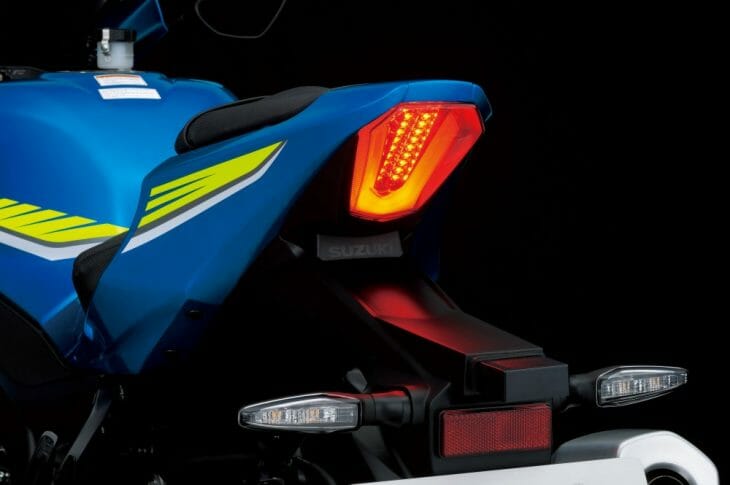 Cute bum. Doesn’t look so good when the rider is past his fighting weight…
Cute bum. Doesn’t look so good when the rider is past his fighting weight…
The Low RPM Assist feature first came out on the 2016 Suzuki SV650. When necessary, the ECM activates the ISC air-bleed system, raising engine rpm slightly for a smoother start. Suzuki claims the system also makes it easier to ride at low speeds in heavy traffic or through a crowded parking lot.
Sadly, for the base model GSX-R, it doesn’t come standard with a quickshifter. You can add one on if you like, but it’s omission is a mark against the bike, in my opinion.
Phew. OK. Let’s ride this thing!
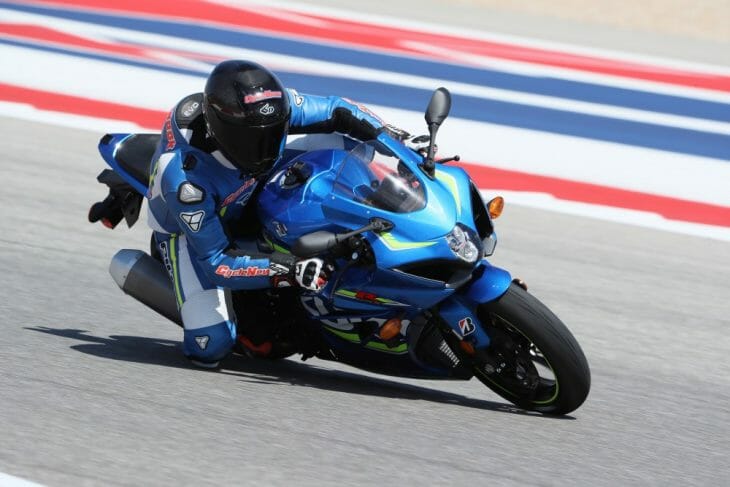 This thing turns. It turns really, really well. And Circuit of The Americas is a great place to test it out.
This thing turns. It turns really, really well. And Circuit of The Americas is a great place to test it out.
Holding it wide at COTA on the Suzuki GSX-R1000
Two days in Texas, one at Circuit of The Americas and the other on the roads at the back of the city, highlight the two sides of the GSX-R’s face.
As my mate Ari Henning says, “taping the throttle on a 1000cc sportbike in sixth is about as good as it gets.”
He isn’t wrong. And Circuit of The Americas is one of the few places in the country you can really let a 1000cc machine have its head. Down the back straight with the motor screaming up through the mid-range, past the 10,000rpm VVT mark and dancing in the top end, the sheer shriek of the blue beast underneath is making me feel drunk on velocity.
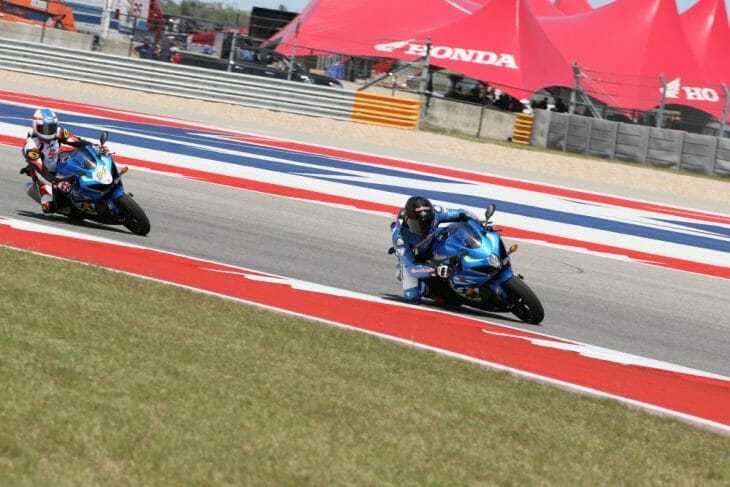 Getting chased by Kevin Schwantz is both exhilarating and utterly terrifying at the same time.
Getting chased by Kevin Schwantz is both exhilarating and utterly terrifying at the same time.
A GSX-R’s intake has a distinct sound to it. It’s meaty, loud, and sounds like it could suck in small children. It’s absolutely to the machine’s detriment that there is no quickshifter as standard on the base model GSX-R as it’d make the back straight even more fun, but I’m not complaining too much. The shift is still nice and smooth, feels pretty much like the old bike, but I’d sure love not to have to back off to snatch that next gear.
In all, the best I see is 172mph on the Suzuki’s dash down the back straightaway. That’s tremendous speed, but the way it gets there is underwhelming. It doesn’t have the manic power of a BMW or the dirty great grunt of a Ducati—the Suzuki just gets on with the job of building speed smoothly and quickly, without much fuss. Very Japanese-like.
The VVT system is pretty damn discreet. I will be honest and say I find it hard to detect when it comes in, watching the dash lights swing past 10K rpm and into the top end. The GSX-R has excellent torque from pretty low down anyway, a feature of past GSX-R1000s, it’s just the new bike feels fuller right through the rev range and after trying the three Suzuki Drive Mode Select modes, I settle on Mode A and leave it there as I like the directness of the throttle response.
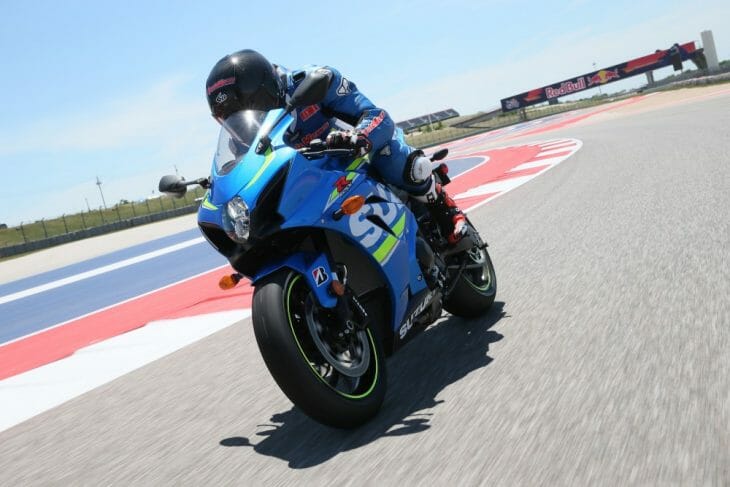 Superbikes are indeed getting smaller, but this Suzuki GSX-R1000 isn’t too hard to fit on.
Superbikes are indeed getting smaller, but this Suzuki GSX-R1000 isn’t too hard to fit on.
On the brakes at the end of the straight and I’d like more power at the lever. There’s good feel, but the overall power isn’t there compared to something like a Kawasaki ZX-10R with its Brembo M50 calipers or the similarly braked Panigale. The Suzuki also runs old school rubber brake hoses, not steel lines, and after 10 laps I come in complaining of brake fade and am surprised to find I’m not the only one. This is at the highest possible speed of braking at COTA, mind you, and for the rest of the lap I don’t really have any braking issues.
One of the Suzuki’s trump cards is the way it falls into a corner. The slimness of the new design allows me to really muscle it through the stadium section and onto the marvelous turn 16, 17 and 18 right hander. This is where the GSX-R is at its best, carving a nice wide arc and yelling at me to stop being a pussy and get on the gas on the exit earlier and harder. We are running the Bridgestone R10 track tires and they complement the GSX-R beautifully, allowing the chassis to show off what it’s good at.
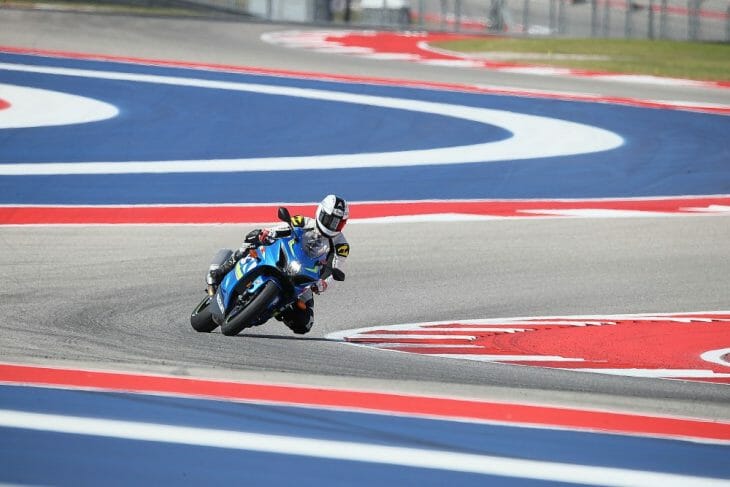 The 2017 Suzuki GSX-R1000’s creator, Shinichi Sahara, knows how to shred on his company’s products!
The 2017 Suzuki GSX-R1000’s creator, Shinichi Sahara, knows how to shred on his company’s products!
From corners two to 10, the GSX-R is a sheer joy. It laps up direction changes, swapping one side for another and rolling through the bends like it’s on rails. Even with the soft Showa BPF, I have very few complaints other than I need to lose some weight to really face up properly to a GSX-R1000. The bike’s diet has made it more compact all round, which in turn makes the GSX-R a far better cornering weapon than last year. And makes me question my own diet.
Through the first session I run traction control on level five, switching to three for the rest of the day and leaving it there. Three allows for controllable slides without getting too gnarly, but although the traction is fine for me at that level, I find the wheelie control kicks in too much and doesn’t allow me to carry it the way I’d like out of corners—very much like the CBR1000RR. Separate functions like the R1 and the Ducati in my mind are the way to go, I guess Suzuki and Honda have other ideas.
The GSX-R1000 is a good track bike but where the 1000 has always shined in my eyes has been on the road. The Suzuki engineers build bikes for people to ride, not just race, so switching to the black stuff around Austin yields, well, nothing surprising.
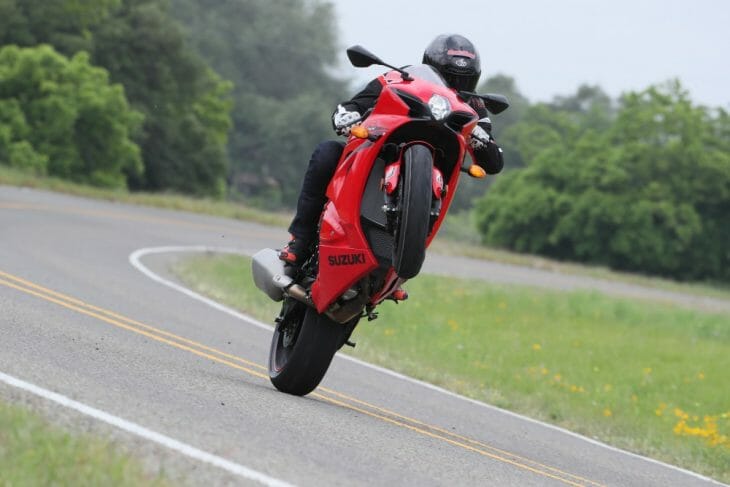 Get out into the backroads and the GSX-R shines bright like a diamond.
Get out into the backroads and the GSX-R shines bright like a diamond.
That’s because the Suzuki GSX-R is still an excellent streetbike. The only discernable difference at legal road speeds is the faster revving short stroke engine and the lack of girth around the tank and seat. Everything else feels exactly as it was—right down the pattern on the handlebar grips. The familiarity between lineages has always been a Suzuki trait, and the 2017 model continues that tradition.
The issues I have on the track regarding braking power and fade don’t even come to mind on the street. The lack of a quickshifter does, but it’s not a deal breaker—especially in Austin where it feels like I can’t get out of fourth gear with all the traffic and lack of lane-splitting allowed.
Comfort-wise, GSX-R isn’t bad. Mind you, if you’re buying a 1000cc sportbike for comfort, you’re probably as tall as Dani Pedrosa. But at 6’1”, I don’t find the reach to the ’bars terribly uncomfortable, nor the ’pegs too high, or the 32.5-inch tall seat too hard. However, give me the option of the GSX-R1000 or the GSX-S1000, and I’ll be head for S town immediately. I’m getting old.
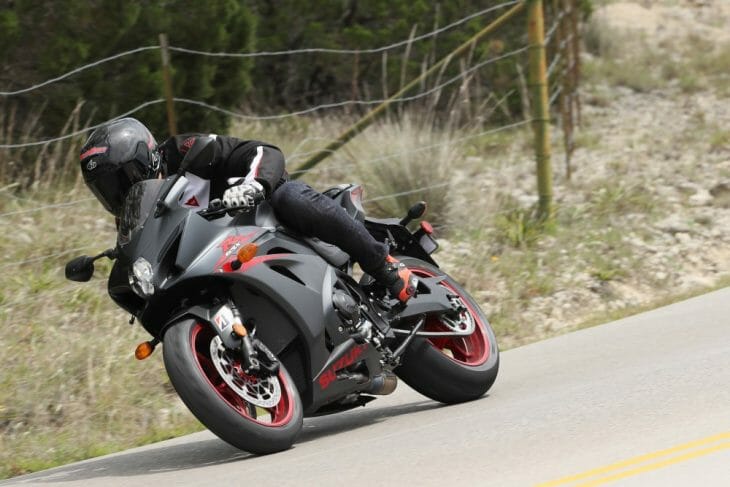 Despite my dislike for black bikes, the red wheels really set this color scheme off well.
Despite my dislike for black bikes, the red wheels really set this color scheme off well.
In my mind, the road is where the Suzuki is going to win hearts. In a sheer power and tech race, there are other superbikes out there that simply have more on offer for straight up track riding/racing. However, the Suzuki comes in at a very respectable MSRP of $14,599 ($14,999 if you want ABS). That’s $400 cheaper than the Yamaha YZF-R1S, a grand cheaper than the BMW S 1000 RR and two grand behind the base model Yamaha YZF-R1. If you never intend on adding some aftermarket bits to your bike, the Suzuki is going to be very hard to beat in the dollar stakes.
Here’s the cynic in me. I’d have liked to see the GSX-R1000R be the base model, and for Suzuki to bring out a super special GSX-R1000RR! A really bad ass bike like the Yamaha YZF-R1M or the Honda CBR1000RR SP2. Imagine that…
Still, the 2017 GSX-R1000 is an excellent machine, and with three bikes on offer, Suzuki is once again back in the superbike game.
Photography by Brian J Nelson
 There’s a lot of race winning pedigree in this photo! Roger Hayden’s 2017 GSX-R is flanked by Alex Rins’ MotoGP GSX-RR, Kenny Roberts Jnr’s 2000 Suzuki RGV500 and the three base model GSX-R1000s.
There’s a lot of race winning pedigree in this photo! Roger Hayden’s 2017 GSX-R is flanked by Alex Rins’ MotoGP GSX-RR, Kenny Roberts Jnr’s 2000 Suzuki RGV500 and the three base model GSX-R1000s.
|
SPECIFICATIONS: 2017 Suzuki GSX-R1000
|
|
Engine:
|
Inline four-cylinder four stroke
|
|
Displacement:
|
999cc
|
|
Bore x stroke:
|
76 x 55.1mm
|
|
Compression ratio:
|
13.2:1
|
|
Fuel system:
|
EFI, 4 x 46mm throttle bodies
|
|
Exhaust:
|
4-2-1
|
|
Transmission:
|
Six-speed cassette
|
|
Chassis:
|
Cast-aluminum twin spar
|
|
Front suspension:
|
43mm inverted Showa BPF fork with, rebound and compression
damping adjustability. 4.7in travel.
|
|
Rear suspension:
|
Showa shock with spring preload, rebound and compression damping
adjustability. 5.3in travel.
|
|
Front brake:
|
Brembo Monobloc 4 piston, radially mounted caliper, 320mm disc
|
|
Rear brake:
|
Nissin single piston, fixed caliper, 240mm disc
|
|
Front tire:
|
120/70 ZR17
|
|
Rear tire:
|
190/55 ZR17
|
|
Rake:
|
23°
|
|
Trail:
|
3.7in
|
|
Wheelbase:
|
55.9°
|
|
Seat height:
|
32.8in.
|
|
Fuel capacity:
|
4.2 gal
|
|
Weight:
|
443 lb (curb, claimed).
|
|
Color:
|
Metallic Matte Black No. 2 / Glass Sparkle Black, Pearl Mira Red, and
Metallic Triton Blue
|
|
MSRP:
|
$14,599
|
|
SPECIFICATIONS: 2017 Suzuki GSX-R1000
|
|
Engine:
|
Inline four-cylinder four stroke
|
|
Displacement:
|
999cc
|
|
Bore x stroke:
|
76 x 55.1mm
|
|
Compression ratio:
|
13.2:1
|
|
Fuel system:
|
EFI, 4 x 46mm throttle bodies
|
|
Exhaust:
|
4-2-1
|
|
Transmission:
|
Six-speed cassette
|
|
Chassis:
|
Cast-aluminum twin spar
|
|
Front suspension:
|
43mm inverted Showa BPF fork with, rebound and compression
damping adjustability. 4.7in travel.
|
|
Rear suspension:
|
Showa shock with spring preload, rebound and compression damping
adjustability. 5.3in travel.
|
|
Front brake:
|
Brembo Monobloc 4 piston, radially mounted caliper, 320mm disc
|
|
Rear brake:
|
Nissin single piston, fixed caliper, 240mm disc
|
|
Front tire:
|
120/70 ZR17
|
|
Rear tire:
|
190/55 ZR17
|
|
Rake:
|
23°
|
|
Trail:
|
3.7in
|
|
Wheelbase:
|
55.9°
|
|
Seat height:
|
32.8in.
|
|
Fuel capacity:
|
4.2 gal
|
|
Weight:
|
443 lb (curb, claimed).
|
|
Color:
|
Metallic Matte Black No. 2 / Glass Sparkle Black, Pearl Mira Red, and
Metallic Triton Blue
|
|
MSRP:
|
$14,599
|